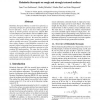Free Online Productivity Tools
i2Speak
i2Symbol
i2OCR
iTex2Img
iWeb2Print
iWeb2Shot
i2Type
iPdf2Split
iPdf2Merge
i2Bopomofo
i2Arabic
i2Style
i2Image
i2PDF
iLatex2Rtf
Sci2ools
3DPVT
2004
IEEE
2004
IEEE
Helmholtz Stereopsis on Rough and Strongly Textured Surfaces
Helmholtz Stereopsis (HS) has recently been explored as a promising technique for capturing shape of objects with unknown reflectance. So far, it has been widely applied to objects of smooth geometry and piecewise uniform Bidirectional Reflectance Distribution Function (BRDF). Moreover, for non-convex surfaces the inter-reflection effects have been completely neglected. We extend the method to surfaces which exhibit strong texture, nontrivial geometry and are possibly non-convex. The problem associated with these surface features is that Helmholtz reciprocity is apparently violated when point-based measurements are used independently to establish the matching constraint as in the standard HS implementation. We argue that the problem is avoided by computing radiance measurements on image regions corresponding exactly to projections of the same surface point neighbourhood with appropriate scale. The experimental results demonstrate the success of the novel method proposed on real object...
3DPVT 2004 | Bidirectional Reflectance Distribution Function | Helmholtz Stereopsis | Non-convex Surfaces | Visualization |
| Added | 20 Aug 2010 |
| Updated | 20 Aug 2010 |
| Type | Conference |
| Year | 2004 |
| Where | 3DPVT |
| Authors | Jean-Yves Guillemaut, Ondrej Drbohlav, Radim Sára, John Illingworth |
Comments (0)

